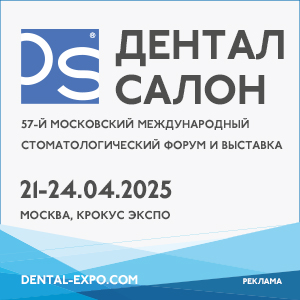Clinical substantiation of application the method of sealing the internal interface of the implant
Downloads
Abstract
During the last two decades implantation in treatment of patients with partial or full absence of teeth has finally asserted itself as a method of choice. However, as any treatment dental implantation has certain percent of complications which may arise at all stages of treatment process and can lead to loss of the fixed and functional implant. A doctor at a prosthetic dentistry clinic usually has to deal with secondary inflammatory complications - peri-implant pathology and peri-implant mucositis. One of the local factors that can provoke development of inflammation is the presence of the microgap in the area of joint of the implant with the abutment and free space directly inside the fixture. Taking into account the fact that notably the center of infection are often the basis of periodontal diseases we can suggest that preventive measures of bacteria expansion from implant interface to the peri-implant zone can prevent development of inflammatory processes in tissues around the implant.Key words:
implant, peri-implant, implantation, mucositisFor Citation
[1]
Badrak E.Yu., Yakovlev A.T., Mikhalchenko D.V., Mikhalchenko A.V., Yarigina E.N. Clinical substantiation of application the method of sealing the internal interface of the implant. Clinical Dentistry (Russia). 2016; 3 (79): 46—49
References
- Воробьев А.А., Шемонаев В.И., Михальченко Д.В., Величко А.С. Взгляд на проблему дентальной имплантации в свете современных научных представлений. - Волгоградский научно-медицинский журнал. - 2009; 2 (22): 19-24.
- Гударьян А.А. Роль аэробной и анаэробной микрофлоры в развитии дентального мукозита и дентального периимплантита. - Вестник проблем биологии и медицины. - 2014; 2 (1): 132-4.
- Колесова Т.В., Колесов О.Ю., Михальченко Д.В., Денисенко Л.Н. Анализ осложнений ортопедического лечения зубными протезами, крепящимися на имплантатах. - Фундаментальные исследования. - 2013; 5-2: 296-9.
- Покровская О.М. Совершенствование комплекса гигиенических мероприятий у пациентов с ортопедическими конструкциями на имплантатах: автореф. дис. … к.м.н., 2008.
- Поройский С.В., Михальченко Д.В., Ярыгина Е.Н., Хвостов С.Н., Жидовинов А.В. К вопросу об остеоинтеграции дентальных имплантатов и способах ее стимуляции. - Вестник ВолГМУ. - 2015; 3 (55): 6-9.
- Соловьева А.М. Периимплантит: этапы достижения консенсуса в диагностике и лечении. - Клиническая стоматология. - 2011; 1: 50-4.
- Яковлев А.Т., Бадрак Е.Ю., Михальченко Д.В., Гришина М.А., Демьянова О.Б. Исследование микрофлоры в области соединения дентального имплантата с абатментом. - Волгоградский научно-медицинский журнал. - 2015; 1: 46-9.
- Clementini M., Rossetti P.H., Penarrocha D., Micarelli C., Bonachela W.C., Canullo L. Systemic risk factors for peri-implant bone loss: a systematic review and meta-analysis. - Int J Oral Maxillofac Surg. - 2014; 43: 323-34.
- Passos S.P., Gressler May L., Faria R., Özcan M., Bottino M.A. Implant-abutment gap versus microbial colonization: Clinical significance based on a literature review. - J Biomed Mater Res B Appl Biomater. - 2013; 101 (7): 1321-8.
Downloads
Published on
September 1, 2016











